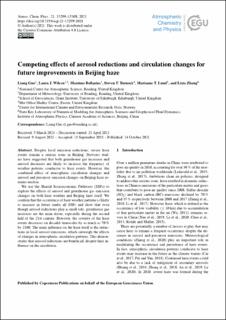| dc.contributor.author | Guo, Liang | |
| dc.contributor.author | Wilcox, Laura J. | |
| dc.contributor.author | Bollasina, Massimo | |
| dc.contributor.author | Turnock, Steven T. | |
| dc.contributor.author | Lund, Marianne Tronstad | |
| dc.contributor.author | Zhang, Lixia | |
| dc.date.accessioned | 2022-04-26T12:17:33Z | |
| dc.date.available | 2022-04-26T12:17:33Z | |
| dc.date.created | 2022-02-15T08:57:08Z | |
| dc.date.issued | 2021 | |
| dc.identifier.citation | Atmospheric Chemistry and Physics (ACP). 2021, 21 (19), 15299-15308. | en_US |
| dc.identifier.issn | 1680-7316 | |
| dc.identifier.uri | https://hdl.handle.net/11250/2992850 | |
| dc.description.abstract | Despite local emission reductions, severe haze events remain a serious issue in Beijing. Previous studies have suggested that both greenhouse gas increases and aerosol decreases are likely to increase the frequency of weather patterns conducive to haze events. However, the combined effect of atmospheric circulation changes and aerosol and precursor emission changes on Beijing haze remains unclear. We use the Shared Socioeconomic Pathways (SSPs) to explore the effects of aerosol and greenhouse gas emission changes on both haze weather and Beijing haze itself. We confirm that the occurrence of haze weather patterns is likely to increase in future under all SSPs and show that even though aerosol reductions play a small role, greenhouse gas increases are the main driver, especially during the second half of the 21st century. However, the severity of the haze events decreases on decadal timescales by as much as 70 % by 2100. The main influence on the haze itself is the reductions in local aerosol emissions, which outweigh the effects of changes in atmospheric circulation patterns. This demonstrates that aerosol reductions are beneficial, despite their influence on the circulation. | en_US |
| dc.language.iso | eng | en_US |
| dc.publisher | EGU | en_US |
| dc.rights | Navngivelse 4.0 Internasjonal | * |
| dc.rights.uri | http://creativecommons.org/licenses/by/4.0/deed.no | * |
| dc.title | Competing effects of aerosol reductions and circulation changes for future improvements in Beijing haze | en_US |
| dc.type | Journal article | en_US |
| dc.type | Peer reviewed | en_US |
| dc.description.version | publishedVersion | en_US |
| dc.source.pagenumber | 15299-15308 | en_US |
| dc.source.volume | 21 | en_US |
| dc.source.journal | Atmospheric Chemistry and Physics (ACP) | en_US |
| dc.source.issue | 19 | en_US |
| dc.identifier.doi | 10.5194/acp-21-15299-2021 | |
| dc.identifier.cristin | 2001625 | |
| cristin.ispublished | true | |
| cristin.fulltext | original | |
| cristin.qualitycode | 2 | |

